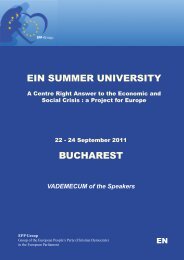TF6 Final Report - European Ideas Network
TF6 Final Report - European Ideas Network
TF6 Final Report - European Ideas Network
You also want an ePaper? Increase the reach of your titles
YUMPU automatically turns print PDFs into web optimized ePapers that Google loves.
<strong>European</strong> <strong>Ideas</strong> <strong>Network</strong><br />
Task Force 6: External Borders of the <strong>European</strong> Union<br />
Post Cadenabbia draft—almost final<br />
Lead Organization:<br />
Constantinos Karamanlis Institute for Democracy<br />
Participating Organizations:<br />
Foundation Pour L’ Innovation Politique<br />
Austrian Institute For <strong>European</strong> Security Policy<br />
Szazadveg Foundation<br />
Free Europe Center<br />
Konrad Adenauer Foundation<br />
Robert Schumann Foundation<br />
Framework<br />
Five years after the end of WW II, six <strong>European</strong> states decided to establish a<br />
closer community of the peoples of Europe to safeguard peace and prosperity in the<br />
region. This effort through the founding and evolution of the ECSC led to the<br />
establishment of the EU, where states converge around common values, norms,<br />
regulations and decision making procedures. During that process, the Member States<br />
of the EU faced the very difficult task of overcoming traditional national policies for<br />
the benefit of the integration.<br />
Successive enlargements created additional challenges to the process of<br />
integration. As a result, the issue of the External Borders of the <strong>European</strong> Union is<br />
of vital importance not only in regard to specific EU policies (i.e. security,<br />
immigration, etc.), but also because of the challenges the Union will have to face as a<br />
consequence of future enlargements. The crucial issue remains that of the <strong>European</strong><br />
Project and how it will evolve: Is it going to be just an open market area? Or is the EU<br />
going to develop into a stronger political entity? In either case it must maintain<br />
clearly definable and secure external borders.<br />
This realization became more apparent last Spring, when the draft treaty for<br />
establishing a constitution for Europe was rejected by two Member States (after<br />
having been adopted by 15), thus creating a political crisis which impacted its<br />
institutions in a manner that could have halted any further integration of the EU as<br />
well as its future enlargement process. Crucial issues concerning the budget, the new<br />
Member States and the new candidate states posed such great dilemmas to the EU that<br />
the very essence, orientation, limits as well as capabilities and prospects of this unique<br />
economic and geopolitical entity came into question.<br />
Moreover, survey results indicated a dramatic decline of the <strong>European</strong>’s<br />
acceptance of the EU and the policies it pursued in the past decade (perhaps including<br />
the recent enlargement with ten new Member States), thus portraying growing<br />
1
eservations towards the absorption of additional new members. All this demonstrates<br />
that the process of <strong>European</strong> integration has arrived at a critical point. In order to<br />
overcome this crisis, the EU has to clarify in what direction it intends to develop and<br />
where its geographical borders are located, since many argue that the Union’s<br />
capacity to decide and act has already been stretched to its limits. Any additional<br />
major enlargement would increase the EU’s internal heterogeneity and widen the<br />
spectrum of divergent interests, creating an enormous risk of gradual paralysis, if not<br />
future disintegration. Consequently, it is important to focus on the task of the Union’s<br />
internal cohesion.<br />
The Union’s Cohesion<br />
The question of how much social and cultural diversity within the EU can be<br />
absorbed must be cautiously evaluated. If the condition that enlargement must<br />
“strengthen the cohesion of the Union” is supposed to remain valid, since the peoples<br />
of the EU aspire for a strong Europe, then the issue of its internal cohesion must take<br />
priority. A strong Europe means efficient institutions and decision making processes,<br />
which are able to solve the problems and address the challenges the <strong>European</strong> society<br />
is facing today, while effectively defending the interests of the Union on a global<br />
scale. Moreover, the EU must gain the trust and acceptance of EU citizens, present a<br />
clear vision of its projected geographical borders, allow for solidarity with the<br />
weakest Member States, institute a common foreign policy, and improve the Union’s<br />
institutional capability.<br />
Considering the latest developments in world affairs, it is obvious that the<br />
citizens of Europe need a clear perspective on their future and they will only develop<br />
acceptance of the EU, if they have a clear picture of its project, i.e. its direction and its<br />
limits. <strong>European</strong>s cannot be expected to support the idea of <strong>European</strong> unity, unless<br />
they have an outlook of what the EU will look like in the short, medium and long run,<br />
as well as which of the existing problems it can solve.<br />
Thus, further enlargements must not only be considered and judged by the<br />
political Copenhagen Criteria, because experience shows that these criteria were often<br />
applied very flexibly. Instead, account must be taken of the very fundamental<br />
objective of its establishment, as expressed in Art. 1.1 of the Constitutional Treaty,<br />
which reflects the will of the citizens and states of Europe to build a common future.<br />
Originally, the desperately needed improvement of the Union’s institutional<br />
and political capacity to act was supposed to take place parallel to the enlargement of<br />
the ten new Member States. Institutional capability to act, therefore, assumes that<br />
before the EU faces further enlargement beyond Bulgaria and Rumania, issues of the<br />
Union’s cohesion and functionality must be resolutely addressed. The EU must pursue<br />
all necessary reforms in order to attain further integration.<br />
Citizens of EU must have the impression that the Union is capable of solving<br />
pressing problems. This means: creating new jobs; generating more economic potency<br />
and modernity in order to overcome the challenges of globalization; fighting more<br />
effectively against terrorism and international crime; and handling environmental and<br />
energy problems more successfully. In that aspect, the ambitions of the Lisbonstrategy<br />
are still valid: flexible labour markets; completion of the Single <strong>European</strong><br />
Market; robust advancement of scientific research; continuous improvement of<br />
professional qualifications. The acceptance of the Union by its people will increase,<br />
once the citizens realize that the EU is much more successful in dealing with global<br />
challenges, than Member States can do on their own.<br />
2
Above all, it appears that there is now a need to reinforce a common and<br />
strongly felt <strong>European</strong> identity. In fact, it is paramount to nurture a “we” feeling.<br />
And for that purpose the norms and values on which the EU is based must strictly be<br />
followed and further cultivated. Otherwise, it would be hardly possible to ask the<br />
<strong>European</strong> citizens to submit to the necessary supranational governance and accept<br />
common policies, which demand at least short term concessions and sacrifices of<br />
national interests. One of the main tasks is to develop a <strong>European</strong> public space and<br />
transnational debates on <strong>European</strong> issues.<br />
Any discussion of further EU enlargement, must address the crucial issue of<br />
the Union’s absorption capacity. And even so, a necessary first step is to tackle the<br />
notion of Europe’s “internal” absorption capacity, that is its ability to ‘bring to the<br />
fold’ the ten new members.<br />
Economic and Social Cohesion -“Internal” Absorption Capacity<br />
By absorption capacity, we shouldn’t simply mean the capacity of the<br />
<strong>European</strong> Union to accept new members. When the subject of cohesion is discussed<br />
in the context of the <strong>European</strong> Union and its enlargement, we should not forget that<br />
besides external borders there are also internal disparities. As a result, when we<br />
consider the ways that the EU could accept new candidates, attention should also be<br />
paid to the full ‘absorption’ of its present members.<br />
Specifically, there are two issues that should be considered: First, due to the<br />
different pace of integration, not all Member States participate in every common<br />
policy (for example, different memberships in the Euro or the Schengen zones.)<br />
Second, as a consequence of the 2002 Copenhagen accession treaties, there are still<br />
strong dividing lines between old and new Member States in several policy areas (in<br />
agriculture till 2013; in structural funds till 2007; in free movement of labour till<br />
2011; etc.) The phenomenon of staggered integration is not new in the EU, however,<br />
as the experience of Greece, Spain and Portugal indicates, these internal<br />
differentiations can be gradually eliminated, when they are properly addressed.<br />
Hence, priority should be given to the elimination of still existing social and<br />
economic differences among the Member States. The EU should never neglect to<br />
concentrate its efforts on implementing its basic principles, such as solidarity and<br />
equality of its members. Consideration should be given to the threat of drawing<br />
dividing lines within the <strong>European</strong> Community (i.e. separating the member countries<br />
according to their level of development) that could undermine the entire process of<br />
bringing the peoples of Europe closer together.<br />
We need and desire a strong Europe. We must then agree to 'maintain the<br />
momentum of integration', and to reinforce the internal cohesion of the EU. Therefore<br />
convergence of those who are lagging behind at the moment should be given priority.<br />
As a consequence, every EU endeavour has to be judged from the point of view of<br />
what its effect on the internal cohesion will be. The EU budget must henceforth be<br />
aligned with the increasing challenges of globalization, while continuing to allow for<br />
solidarity with the weakest Member States.<br />
3
Absorption Capacity for New Candidates<br />
The three criteria for the accession of new members, which have been<br />
determined at the Copenhagen Council on June 21 st 1993, have over time been<br />
defined in every detail. Concerning the criteria of absorption capacity, however, there<br />
are no more than three phrases. The <strong>European</strong> Union should be able to absorb new<br />
members, while at the same time “maintain the dynamic of the <strong>European</strong> integration.”<br />
Furthermore, “the enlargement [should] strengthen the process of continuing<br />
integration” and “every effort should be made to maintain the cohesion and<br />
effectiveness of the Union.”<br />
In a resolution adopted in March 2006, the <strong>European</strong> Parliament called on the<br />
Commission to submit a report by 31 December 2006 setting out the principles, which<br />
underpin the concept of the EU’s absorption capacity. According to the MEPs,<br />
“defining the nature of the <strong>European</strong> Union, and including its geographical borders, is<br />
fundamental to understanding the concept of absorption capacity.” The text approved<br />
by the Parliament also said that “the capacity for absorption of the Union… remains<br />
one of the conditions for the accession of new countries.” It seems then that the term<br />
“absorption capacity” must be clearly defined.<br />
There can neither be a regressive development of the EU (for example in the<br />
direction of an upgraded free-trade-area), nor should the present state of integration be<br />
simply held up. Rather, the cohesion, effectiveness and capability to act must be<br />
improved and the integration process must be further deepened. If the concept of<br />
absorption capacity is supposed to be more than an empty phrase, it must now be<br />
specified in detail, especially regarding any future enlargements beyond Bulgaria,<br />
Rumania and Croatia.<br />
It will thus be necessary to fully apply the accession criteria, including the<br />
criterion of the Union’s absorption capacity (see Annex), to all new candidate<br />
countries. It has to be obvious for everyone that no political or other considerations<br />
can overrule these criteria and their full implementation is an imperative for every<br />
new candidate. We must put emphasis on the clarity of the content of the term “the<br />
membership's political conditions”.<br />
When the accession of a <strong>European</strong> country is on the agenda, the potential<br />
consequences of financial and other costs of membership have to be carefully<br />
evaluated. All EU policies have to be analysed from the point of view of what the<br />
implications of the accession of a certain <strong>European</strong> state would be for that specific<br />
policy. The implications on the institutional architecture, above all the effective<br />
functioning of the Union’s ability to decide and act efficiently, should be accessed.<br />
The preservation of this ability would have to be assured. Unless this lengthy and<br />
difficult work is done, no justifiable decisions on any further accession can be taken.<br />
Specific criteria adopted to define the Union’s absorption capacity should be<br />
based on the following parameters:<br />
• The impact on the nature of the <strong>European</strong> project – how would it be effected,<br />
can it be preserved and the momentum of integration maintained? Priority to<br />
be given to the consolidation of the existing Union.<br />
• The effect on identity-building, i.e. the impact on cultural cohesion and the<br />
preservation and strengthening of the “We” feeling.<br />
• The candidate member’s political and social compatibility with the values and<br />
structures of existing Member States and the Union as such.<br />
4
• The acceptance by the people, i.e. effect on the identification of citizens with<br />
the <strong>European</strong> project, which in turn presupposes cultural, political and<br />
economic cohesion, clarity about the Union’s borders and not only with its<br />
geographic, but also cultural and political dimension.<br />
• The impact on the functioning of the Union, i.e. its ability to decide and act<br />
efficiently. This is a precondition for ensuring that the EU is a political and<br />
institutional order with strengthened supranational structures and procedures at<br />
least at a level as conceived in the Constitutional Treaty.<br />
• The size of the candidate country and its impact on the internal balances of the<br />
Union.<br />
• The financial implications, i.e. financiability.<br />
• The impact on individual EU policies and strategies.<br />
• The impact on external and internal security: a pre-eminent function and aim<br />
of the Union is to ensure external and internal security. The question of a<br />
secure Union is therefore crucial. In the context of the external borders, the<br />
potential security risks have to be given special attention and must be<br />
answered clearly.<br />
Moreover, priority must be given to receiving satisfactory answers as far as<br />
the criteria of the absorption capacity are concerned before evaluating and<br />
deciding the question of candidate status on the basis of the accession criteria as<br />
laid down in the Treaty and the Copenhagen Criteria. In the future, the political<br />
Copenhagen Criteria have to be strictly and credibly fulfilled before negotiations<br />
can be taken up. In addition, EU Institutions should take full account of the<br />
opinion of the Union’s citizens when they are examining any new candidate states<br />
for membership.<br />
Further, the EU should insist that priority must be given to the establishment<br />
of a monitoring mechanism to be applied during negotiations as well as after<br />
negotiations, and until there is a complete and unequivocal compliance with all<br />
terms and conditions by the new member(s).<br />
The case of Turkey<br />
The case of the Turkish accession has amplified the growing concern about an<br />
unmanageable and boundless EU. After all, if the EU should become a direct<br />
neighbour of Iran, Syria, and Iraq after Turkey’s accession, this would raise serious<br />
questions about both the inner and the outer security of the EU.<br />
Many argue over the capability of the EU to successfully absorb Turkey in the<br />
<strong>European</strong> community in the near future. In any case, Turkey should continue its<br />
reforms towards meeting the criteria for entry into the EU zone, while keeping in<br />
mind that “Membership requires that the candidate country has achieved several<br />
conditions: stability of institutions guaranteeing democracy; respect for the rule of<br />
law, and human rights; respect for and protection of minorities; the existence of a<br />
functioning market economy; as well as, the capacity to cope with competitive<br />
pressure and market forces within the Union. Membership presupposes the<br />
candidate’s ability to take on the obligations of membership including adherence to<br />
the aims of political, economic and monetary union.” As to the timing of the process,<br />
all aspects of the Union’s absorption capacity must be fully considered. Then and in<br />
addition, only full and unequivocal compliance by Turkey of all terms and conditions<br />
5
for full membership (there should be no rebates or discounts on political criteria), can<br />
lead to Turkey’s entrance into the Union.<br />
Remaining <strong>European</strong> States<br />
The Constitutional Treaty, which has not yet been ratified, declares the basic<br />
perspective that the “Union is open to all <strong>European</strong> states respecting its values and<br />
willing to collectively further these values” (Art I-1-2). However, it will have to be<br />
estimated in every single case whether or not and to what extend the EU is capable to<br />
absorb the accession of another state at a specific date, judged on the basis of its inner<br />
development.<br />
Enlargement must not be conceived as the only political instrument to promote<br />
democratic reform and create stability in the Union’s neighbourhood. At any cost, it<br />
must be avoided that the Union by enlarging itself, it is weakened and becomes itself<br />
an object of destabilization. Therefore, incremental forms of cooperation within<br />
specific timeframe may be developed for Balkan countries, which encourage them to<br />
converge toward EU norms and ideals. Without discounting at all, strict inclusion<br />
criteria or compromising the EU’s absorption capacity, remaining <strong>European</strong> States<br />
may be offered the prospect of future inclusion to the <strong>European</strong> family.<br />
Hence, the inclusion of all Balkan states in the EU should remain on the<br />
agenda, provided that they satisfy the Copenhagen criteria. This development could<br />
safeguard peace and stability in the region. After all, it is also in the security interest<br />
of the EU, if the states of the western Balkans have the prospect of joining the Union.<br />
In addition, this will certainly relieve the EU from further diplomatic and economic<br />
burdens.<br />
In the Balkans, the recent wars have created new divisions between peoples<br />
and nations and the process is not over yet (see developments in Montenegro and<br />
Kosovo). The future integration of these new states in the EU will reduce the new<br />
divisions between them, and as a result, accelerate the process of rapprochement and<br />
reconciliation in the entire region. In other words, it will be easier for them, to accept<br />
the creation of these new dividing lines between Serbia and Montenegro or Kosovo as<br />
they anticipate their inclusion into the Union. This is why the prospect of their<br />
integration has to be very clear and reaffirmed, in order to relax any negative effects<br />
of the current process of new border creation.<br />
In that aspect, the EU must introduce clear-cut commitments and a specific<br />
framework for action that will guide the remaining Balkans states through specific<br />
procedures towards their inclusion in the <strong>European</strong> Union. Road maps should be<br />
drawn indicating the necessary steps for the proper preparation for future<br />
membership. These roadmaps should be meaningful and their implementation should<br />
be a must for each candidate.<br />
“Good Neighbourhood”<br />
It has been argued that if the <strong>European</strong> Union comes to the conclusion that it is<br />
not capable to accept an application of full membership of a certain state because of<br />
its inner conditions, this must not be a question of “pass or fail.” Rather there are<br />
interim solutions and alternatives for a closer relations like close, privileged<br />
partnerships which should be “tailor-made” according to the necessities and needs of<br />
the respective partners.<br />
6
At this point, we should mention that EU frontiers should not be necessarily<br />
associated only with the enlargement procedures and the inclusion of further<br />
<strong>European</strong> states into the EU. Instead, we should also devote our attention to the<br />
special and “privileged” relations of the EU with its neighbouring countries. “Good<br />
Neighbourhood Offices,” are necessary to the success of this procedure, since we<br />
strongly believe that we need to improve our relationships with the remaining<br />
<strong>European</strong> countries that are not to join the EU family.<br />
In its Communication "Wider Europe Neighbourhood: A New Framework for<br />
Relations with our Eastern and Southern Neighbours,” the Commission proposed that<br />
"the <strong>European</strong> Union should aim to develop a zone of prosperity and a friendly<br />
neighbourhood … with whom the <strong>European</strong> Union enjoys close, peaceful and cooperative<br />
relations… Over the coming decade and beyond, the Union’s capacity to<br />
provide security, stability and sustainable development to its citizens will no longer be<br />
distinguishable from its interest in close co-operation with the neighbours.” The<br />
development of such a policy is a logical consequence of enlargement, which, as<br />
stated in the Communication “gives new impetus to the effort of drawing closer the<br />
385 million inhabitants of the countries who will find themselves on the external land<br />
and sea border, namely Russia, the Western NIS, and the Southern Mediterranean."<br />
As a result, the Good Neighbourhood policy of the EU is focused on<br />
interdependence with these countries that have recently found themselves at the<br />
Union’s frontiers as well as those that will be in the future. Such issues as illegal<br />
immigration, human trafficking, and human rights remain the most important to be<br />
examined. Promotion of free trade and cooperation in the mentioned issues of<br />
interest, among the Union and its neighbours should help ensure greater prosperity<br />
and stability at the new EU borders. However, the issue of terrorism and security<br />
should attract our greatest attention in the immediate future, as the EU expands<br />
towards the turbulent Middle East.<br />
Conclusion<br />
The issue of the Union’s external borders and future enlargements is fully<br />
interlinked with its absorption capacity. Clarifying the question of absorption capacity<br />
of the EU does not as such aim at averting new members. It is a strategy to preserve<br />
the cohesion of the Union, to maintain its capability to decide and act, and a s result<br />
to assure the full support of its citizens. A strong, effective, efficiently functioning<br />
Union enhances determinedly its general absorption capacity for future enlargements.<br />
As we attempt to define the term ‘absorption capacity’, we should keep in<br />
mind that besides setting straight the limits, the vision and the orientation of the EU,<br />
we must focus on the nature of the relations of the Member States within the Union<br />
and the danger of separating the “new” from the “old” Member States, whereas these<br />
two groups could end up experiencing separate levels of integration. The impact on<br />
the internal unity of any further enlargement has to be evaluated. Enlargement should<br />
not be pursued at the expense of cohesion.<br />
The enlarged EU, in its present state of uncertainty over its institutional<br />
reforms and adaptations, indispensable for its functioning and problem-solving<br />
capacity as well as the full integration of its new members, should seriously consider<br />
a period when internal consolidation enjoys a clear priority over continued<br />
enlargement activities and considerations. In addition, the effective entry into force of<br />
the institutional reforms in particular as foreseen by the Constitutional Treaty, is to be<br />
considered the a priori condition for further enlargement.<br />
7
In summary, the issue of EU External Borders should be considered and<br />
evaluated within a framework which is based on the following essential principles:<br />
• There is a need for a strong EU, able to decide and act efficiently and to<br />
develop the integration process further towards the objective as laid down in<br />
the Treaties.<br />
• The <strong>European</strong> Union has always been more than a mere economic project. The<br />
<strong>European</strong> peoples unite and work on the basis of shared core values. This has<br />
also been clearly and unequivocally stated in Art. 6.1. TEU which forms the<br />
basis on which the EU is founded.<br />
• The main goal of the <strong>European</strong> integration process is to overcome traditional<br />
power politics based on the national interests of the <strong>European</strong> nation-states by<br />
building a new <strong>European</strong> order established on a common framework of<br />
<strong>European</strong> law; common institutions and procedures; and an independent<br />
<strong>European</strong> judiciary which would guarantee that in the future the rule of law<br />
should govern relations among member states. The purpose of the <strong>European</strong><br />
integration process is not only to create a <strong>European</strong> zone of economic welfare<br />
and strength, but to establish a stable order of peace. Its political finality is to<br />
develop an ever closer Union of the peoples of Europe.<br />
• The realisation of the <strong>European</strong> integration project demands a gradual though<br />
dynamic process of pooling partial national sovereignties and competences<br />
which are then exercised in the Union’s institutions to shape common policies<br />
in order to solve common problems and safeguard Europe’s interests on the<br />
global scene.<br />
• The EU is more than a multilateral organisation and has created a political<br />
Community which establishes interrelationships between the Member States,<br />
common institutions and the <strong>European</strong> citizens.<br />
• Its finality was already laid down in the Rome Treaties. The Treaty of<br />
Maastricht established a new quality in the integration process; the EU was<br />
established, and the building of a political Union became an agreed objective<br />
of EU Member States.<br />
• A perceived <strong>European</strong> identity and the awareness of common interests and a<br />
common fate are indispensable for the acceptance of the integration process by<br />
the <strong>European</strong> citizens. It is a precondition for their readiness to agree to the<br />
pooling of national sovereignty and national competences which in turn is<br />
indispensable for preserving and strengthening the Union’s capacity to decide<br />
and act, i.e. its problem solving capacity.<br />
• Each enlargement inescapably leads to additional internal disparities thus<br />
widening the spectrum of divergent interests and increasing internal<br />
heterogeneity. The latest enlargement has practically doubled the Union’s<br />
membership and further increased the degree of internal disparities. This<br />
underlines the urgent need to build a strong <strong>European</strong> identity, politically<br />
effective in terms of forming a firm and endurable basis for common action.<br />
8












